Following the announcement from the Prime Minister regarding the UK’s response to the coronavirus crisis, we are asking leisure boaters to stop all non-essential travel. As a result, and to help those who live-aboard (along with those who would need to travel to their boat in order to move it) we are suspending the requirement to move every 14 days.
Read More
Monthly Archives: March 2020
call for urgent support for waterways businesses
CRT, British Marine & Broads Authority send joint letter of correspondence to the Rt Hon George Eustice MP, Secretary of State for Environment, Food and Rural Affairs. The letter calls for urgent support for waterways businesses. The unprecedented impact of the COVID-19 pandemic presents them with a unique challenge that puts their futures at risk.
Read More
walking the cheshire ring 2
a canal wanderer
walking the cheshire ring - 2
The walks were done between 2017-19. For all walkers today, and with uncertain times ahead of us, please keep safe and take care.
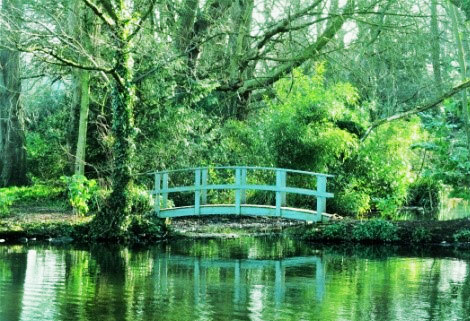
Bridgewater Canal near Thelwall
Over the past three years, I have walked on or off The Cheshire Ring with an intention of doing it either in a clockwise or anti clockwise direction starting at the Ashton Canal. It turned out that I walked the ring in no intended order as friends and family wanted to join me. I had opportunities to enjoy a number of return visits to the Ashton, Peak Forest and Macclesfield Canals. We didn’t literally follow the “ring” either way due to logistics i.e. transportation and in some cases we had to park the car at a nearest town and get the bus/train to the canal.
This is the second article of my Cheshire Ring walking experience. My experiences include multiple trips to the canals and they are consolidated into the canals’ summaries as below.
Rochdale Canal
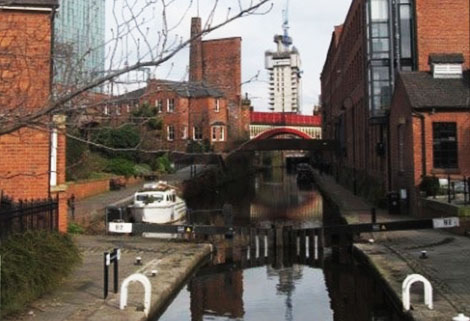
Lock 92, Rochdale Canal, Manchester
On the Rochdale Canal in Manchester we descended underground to Piccadilly Locks, 84 and 85.
This area was insalubrious and seedy to say the least and we passed people smoking illicit substances and we noticed needles on the towpath.
We soldiered on and continued towards Canal Street, the heart of Manchester’s Gay District, towards Lock 86. Apart from the lovely, colourful, safe and relaxed Canal Street, it was an uneventful walk down to the final lock, 92, and beyond this lock is where the Rochdale meets with the Bridgewater Canal.
Bridgewater Canal
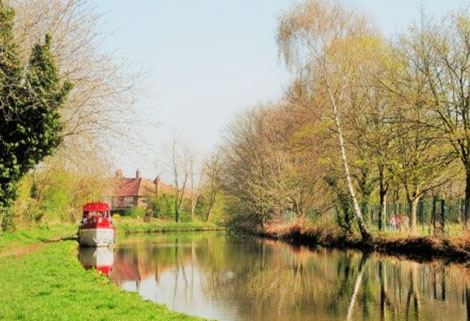
Bridgewater Canal near Grappenhall
We began our adventure on the Bridgewater Canal at Castlefield, Manchester, and joined the towpath.
We saw the Ponoma locks where the boats are able to access the River Irwell and subsequently the Manchester Ship Canal. We also passed Manchester United’s football stadium and eventually reached Waters Meeting point, not the prettiest sight on the canal. Some walks we would have walked right towards the Leigh Branch towards Worsley and eventually Leigh via its infamous Barton Aqueduct (we walkers go across the road’s swing bridge).
On another walk we started walking to the main branch from the Trafford Centre, a large shopping centre on the Leigh Branch, passed the Kellogg’s factory, and eventually reached the Waters Meeting Point. We walked to Altrincham via a brunch stopover at a café in Stretford and through the trendy suburb of Sale. The Main Branch was interesting and we took the opportunity to observe the sights and sounds. We also the crossed an aqueduct over the River Mersey: this river marks the once historic county boundary between Lancashire and Cheshire. On arrival in Altrincham we got the bus back to the Trafford Centre.
Our subsequent walk from Altrincham to Grappenhall took us on a journey from the Greater Manchester suburbs to the countryside. We passed the Victorian Linotype factory where the façade has been incorporated into a new housing estate (being built at the time of walking). We passed the Dunham Massey Estate and soon after stopped for a drink at the Barn Owl Inn. After Lymm and meeting the Trans Pennine Trail, we reached Grappenhall and got the bus back to Altrincham.
Our final walks on the Bridgewater Canal were done over a weekend and we used Warrington as a base to access the canal by public transport. We picked up our walk from Grappenhall and continued on towards Stockton Health, a popular suburb of Warrington and near the Manchester Ship Canal. We stopped there for a drink at The London Bridge Inn. We had glorious weather throughout which made our walk through the Cheshire countryside a pleasant one. I stopped for an ice cream at Moore’s village shop and we walked the remainder of the canal to Preston Brook Tunnel. There we explored the tunnel’s portal and walked to East Runcorn for our bus back to Warrington. We also explored the Runcorn Branch of the canal on another day and it is such a nice stretch especially walking through the Norton woodlands.
Trent & Mersey Canal

Trent & Mersey Canal
Our first walk on the Trent and Mersey Canal walking adventure was from Middlewich to Kidsgrove. It was a tough 13 miles or so walk as it was a very hot day.
We parked in Crewe and caught the bus to Middlewich and we ascended up the canal via its locks and I briefly checked out the Wardle Canal, one of the shortest canals on the network and now incorporated in the Shropshire Union Canal’s Middlewich Branch.
The beginning of our walk isn’t the prettiest with evidence of industrial activity connected with the production of salt. We continued onto the Sandbach area and reached Wheelock where we stopped for a drink.
From Wheelock the canals begin to become more rural and interesting, particularly with its double locks as we were descending. We went under the busy M62 motorway at Hassal Green and up Heartbreak Hill. After a long exhausting walk we reached Kidsgrove – where James Brindley, the famous canal engineer is buried. Before catching the train back to Crewe, we had a look round the Northern Portal of the Harecastle Tunnel.
Our penultimate walk was from Anderton to Middlewich and we caught a bus from Northwich, where we parked the car, to Anderton. On arrival and before we started the walk, we had a coffee stop at the Anderton Boat Visitors Centre’s Café. We were hoping to visit the Salt Barge Pub in Marston but it was closed as we arrived a little early. Instead went to the Lion Salt Works Museum. There my Dad had a look round the museum while I indulged in a Cheshire Cream tea.
After an enjoyable visit there we continued our way towards the industrial landscape of Northwich’s outskirts. Resulting from the salt mining industry and its subsidence we passed numerous flashes (lakes) en route to Middlewich and along the River Dane and the Dane Valley Way. We eventually reached Middlewich Big Lock and had a drink at the Bridge Lock Pub. It was nice to watch the boating activity down below from the balcony. It was a short walk to the bus stop for our bus back to Northwich. We had a little look round Northwich, a charming town centre by the River Weaver and with black and white Tudor style buildings on its high streets.
Our final walk was a circular one from Anderton and back via the River Weaver and the canal. We turned left on the canal after a pit stop for coffee at the visitors centre’s café and reached Soote Hill Bridge where we walked towards Saltersford Lock. There we met a friendly dog and we had a play with it. We continued on to Little Leigh where we had a drink at The Leigh Arms, besides the Action Swing Bridge. The black and white swing bridges on the navigation fit nicely with the landscape. We even saw a ferry boat in operation on the navigation with day trippers on board.
We did the final stretch to Dutton Locks and walked the Delanmore way to rejoin the Trent and Mersey Canal. We did the short walk to the stop lock and the Preston Brook Tunnel at Dutton. We then retraced our steps towards Saltersford and Barnton Tunnels where we walked over the tops. We eventually reached Anderton where we joined the car for the journey home.
We have now completed walking the Cheshire Ring Towing Path. We saw and experienced a lot of interesting sights and things over approximately 100 miles of walking. It’s a popular cruising ring but also it’s a popular walk which we were glad to do. I look forward to sharing another walking experience on another canal in the not too distant future.
the wrong way round #by boat
the wrong way round #by boat
by Rob and Lesley Pearson
The Wrong Way Round #byboat is a journey of discovering the 2,000 miles of inland waterways. This of course led to Lesley & Rob taking Artistic licence to record their adventures, by drawings, maps and the written word.
Rob & Lesley Pearson have been travelling traders since 2014. Lesley is an Artist who has taken to creating drawings and maps of their journeys. Rob is a computer programmer.
 Rob's claim to fame are his jottings about the beginnings of their journey on NB Hekla. They came into being initially as a short story about ‘The Long Way Round’ which was featured in Canal Boat Magazine. The success and feed back from this article prompted Rob to divulge more of the journey, as the magazine article alone didn’t seem to give enough of the essence of that journey.
Rob's claim to fame are his jottings about the beginnings of their journey on NB Hekla. They came into being initially as a short story about ‘The Long Way Round’ which was featured in Canal Boat Magazine. The success and feed back from this article prompted Rob to divulge more of the journey, as the magazine article alone didn’t seem to give enough of the essence of that journey.
Rob's book came to life in 2015 as ‘The Wrong Way Round’ which is available on Amazon.
Lesley is a member of the Guild of Waterway Artists and of the Association of Animal Artists. She describes herself as a travelling artist: "the journey is the artwork and the art work is the journey". For the last four years the Pearsons have been exploring the inland waterways, with Lesley making drawings & maps of things they have seen, and putting her art together with Rob's prose - so combining history and the things they encounter.
Lesley offers prints of her beautifully illustrated maps for sale, as well as prints of her waterways and countryside paintings. She also sells mugs with her paintings on and stunning cards for all occasions.
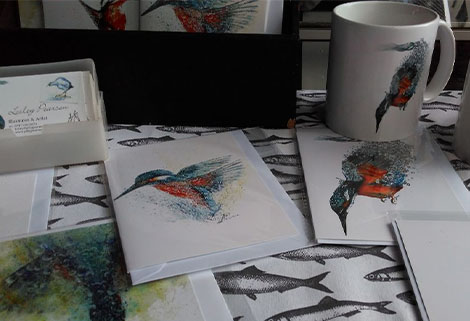
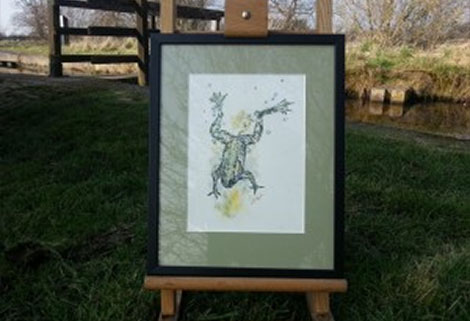
our journey
We have travelled almost all of the northern canals and river navigations in the UK. It has been a carry on from our genuine interest of ways to travel. It’s a way of seeing a country, people, and how people live and interact with each other. We try to embrace it as a way of life, which leads me on to ‘steampunk’, an alternative way to look at life and to what is important about how you embrace it.
steampunk
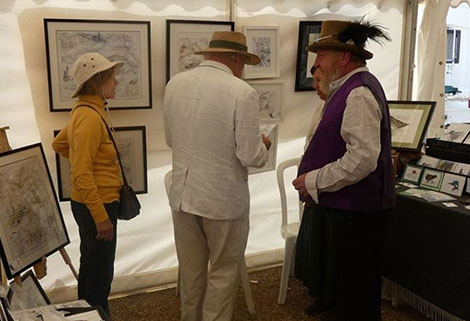
Our alter egos are Captain Pepsi and Miss Mavis Ming; which is why you will see us dressed in a peculiar way. Time travellers from the last century - with a tongue in cheek humour which we find amuses people we meet.
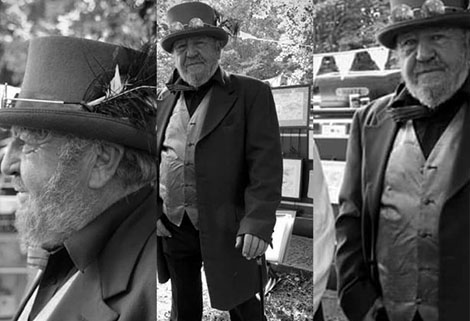
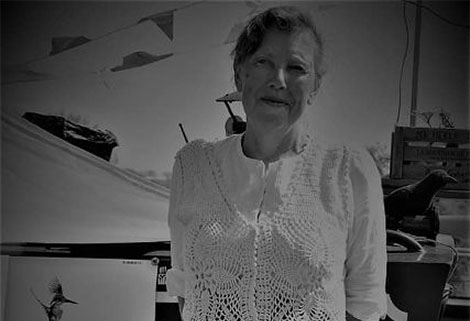
NB Hekla PopUp Art
 It is what it is.. we PopUp in unexpected places, much to the surprise of our followers. We enjoy festivals, markets and of course we open up in places we visit - be it a town, city or just out on the towpath. There is no rhyme or reason to it - it’s what takes our fancy.
It is what it is.. we PopUp in unexpected places, much to the surprise of our followers. We enjoy festivals, markets and of course we open up in places we visit - be it a town, city or just out on the towpath. There is no rhyme or reason to it - it’s what takes our fancy.
This year has been a bit strange as we were deciding to head South for the summer. However, as with most people, Corvid19 has put a halt to any plans we might have had. We just watch the tide and see where it will take us. We are currently on the Chesterfield Canal in Nottinghamshire, waiting for the news of the all clear. Then we will be off South, hopefully.

 Rob and Lesley are currently open for business on the Chesterfield Canal, and of course with their on-line shop.
Rob and Lesley are currently open for business on the Chesterfield Canal, and of course with their on-line shop.
Check out their webpage for more of what they are and have been up to; follow NB Hekla PopUp Art on Facebook, and visit their on-line shop.
To buy a copy of The Wrong Way Round, visit Amazon.
rescue of river soar narrowboat
rcr to rescue narrowboat on river soar
River Canal Rescue will be raising the capsized narrowboat at Barrow, on the River Soar, on Wednesday 25 March. Torrential rain and surging water caused the boat to break its moorings, sending it down river to bridge 30 where it became wedged.
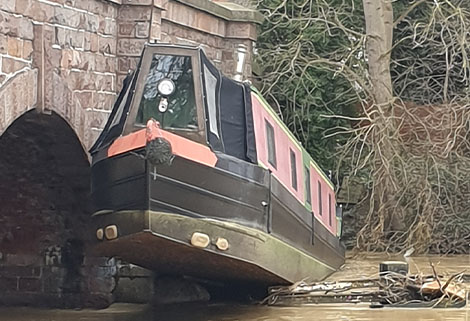 The vessel was left in a precarious position, with the bow in the air and stern in the water, see-sawing on the barrier. A refloat could not be undertaken until flood waters receded, however as levels quickly went down, the barriers gave way, resulting in the vessel capsizing and becoming trapped between the bridge pillars and the barrier pole.
The vessel was left in a precarious position, with the bow in the air and stern in the water, see-sawing on the barrier. A refloat could not be undertaken until flood waters receded, however as levels quickly went down, the barriers gave way, resulting in the vessel capsizing and becoming trapped between the bridge pillars and the barrier pole.
This multi-agency rescue will also involve Essex Boatyard and Crouch Recovery. RCR managing director Stephanie Horton explains: “The best way to undertake this recovery without the vessel overturning and sinking in the river is to use divers, airbags and plant machinery. We’ll inflate the airbags, right the boat and then pull it forward away from the bridge with airbags on it. We’ll then pump it out, make it secure and tow it to a safe location – Pillings Lock.”
From here, the boat will be lifted onto a transporter and taken to a local yard for storage and assessment.
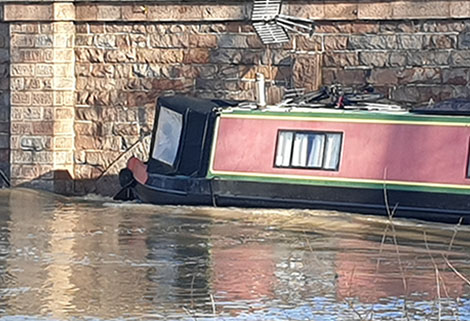 Given the extreme weight of the boat, RCR is using four winches with a total of 20-ton capacity to pull it away from the bridge. Stephanie continues: “This ‘pulling power’ will be attached to plant machinery and we’re removing a fence in the field opposite to get access to the location without causing too much damage to the meadow.”
Given the extreme weight of the boat, RCR is using four winches with a total of 20-ton capacity to pull it away from the bridge. Stephanie continues: “This ‘pulling power’ will be attached to plant machinery and we’re removing a fence in the field opposite to get access to the location without causing too much damage to the meadow.”
In order to prepare the rigging, Essex Boatyard practised on a narrowboat that was capsized at the same angle as the stricken vessel.
River Canal Rescue will be onsite from Monday 23 March, preparing equipment, strapping the boat and managing health & safety issues.
Narrowboat Rescue on 25th March
photos by Mike Brown
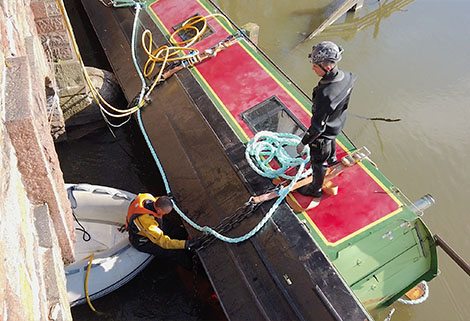


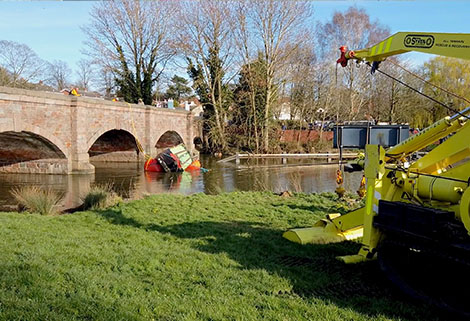
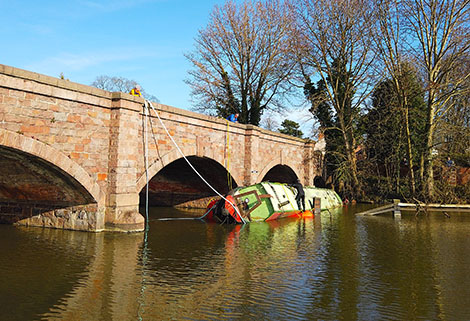
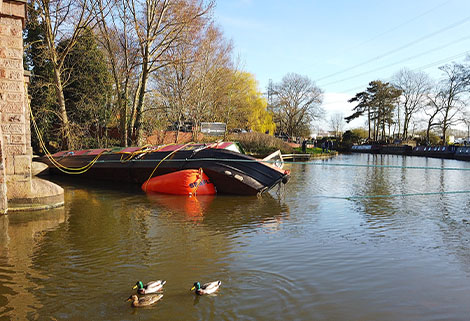
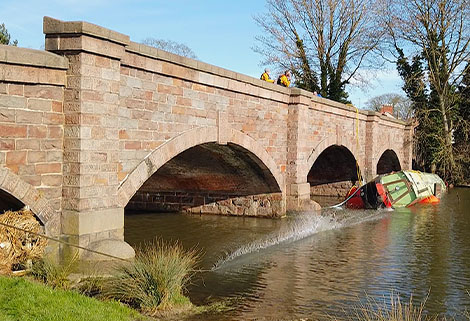
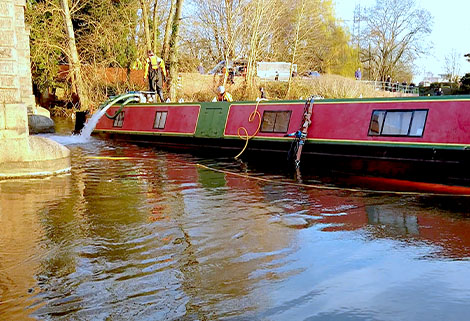
rcr rescues narrowboat on river soar
River Canal Rescue will be raising the capsized narrowboat at Barrow, on the River Soar, on Wednesday 25 March. Torrential rain and surging water caused the boat to break its moorings, sending it down river to bridge 30 where it became wedged.
Read More
castles and roses
castles and roses
phil speight introduces his dvds and tells us how he came to make them
course bookings now being taken
Book your course today. Learn signwriting skills and become an expert in painting castles and roses from the well renowned Phil Speight
To book your place or request further information, see contact details below
Canals Online asked me to write a piece about my motivation in producing a series of tuitional DVDs on traditional narrow boat decoration: I thought it would be easily done. However, having thought about the subject for three or four days now, it seems it was harder than I expected it to be!
To do so I must go back forty years, to the beginning of my career on the canal. The first roses and castles I painted were much admired by friends and family. This, and my own satisfaction with them, was – I now realise – misplaced. In short, they were attractive in their own way, but WRONG. Not perhaps wrong in their actual appearance, but wrong in the description I knew them by. I described them as ‘traditional canal art’ and certainly, the word art in itself begs the question – was it in fact art, or was it craft? The distinction has not gone away with the passing of the years. It’s still a valid question. My bigger error was in describing them as ‘traditional’. I did so because at that time, I had not made the in-depth study of canal art and culture which I am still pursuing to this day. It seems to me that, innocently enough, my mistake is one that many modern painters still make.
 Times have changed on the canal. The ‘old days’ are fading and a whole new community of canal dwellers and leisure boaters has arrived. This cannot be a bad thing, because it ensures that we still have canals to enjoy. With it has come a whole new generation of painters, many of whom have taken up painting roses and castles. A substantial number of these are producing attractive work, which is much admired but has drifted away, over the years, from the original.
Times have changed on the canal. The ‘old days’ are fading and a whole new community of canal dwellers and leisure boaters has arrived. This cannot be a bad thing, because it ensures that we still have canals to enjoy. With it has come a whole new generation of painters, many of whom have taken up painting roses and castles. A substantial number of these are producing attractive work, which is much admired but has drifted away, over the years, from the original.
Roses and castles were, in the days of the working boats long before the leisure boom, part of the culturally important decoration applied to the boats. Working canal families, a completely separate subculture, had many cultural, social and working practices that were entirely their own. The decoration on the boats was of great importance to them. It appeared not only on the boats themselves, but also on some items of boating equipment: water cans, nose tins, hand bowls, cabin stools, seat boards and so on. The flowers were bold, as big as the space would sensibly allow, and painted with great verve and vigour.
 Nowadays the painting has, quite understandably, spread to all manner of items which can be acquired, painted and sold more easily than the original boating equipment. As a result of this, when some of this painting is applied to boats and associated items, it does not have the power and panache of the original. It has been developed for much smaller articles, and a much different market. None of this implies any criticism of the excellent painters who are producing this work. It is simply that the traditional motifs which we all love have, of necessity, been greatly modified and adjusted to suit a completely new range of artefacts. Consequently, they can’t rightly be described as ‘traditional’ good as they are.
Nowadays the painting has, quite understandably, spread to all manner of items which can be acquired, painted and sold more easily than the original boating equipment. As a result of this, when some of this painting is applied to boats and associated items, it does not have the power and panache of the original. It has been developed for much smaller articles, and a much different market. None of this implies any criticism of the excellent painters who are producing this work. It is simply that the traditional motifs which we all love have, of necessity, been greatly modified and adjusted to suit a completely new range of artefacts. Consequently, they can’t rightly be described as ‘traditional’ good as they are.
Now, to my DVDs. They were produced for a number of reasons. One has to be money! But be assured that the amount earned this way should be seen as beer money, not a significant proportion of my income. Secondly, they are self-published and I suppose there must be a degree of ego or vanity involved.
The main reason, though, is that I wanted to record, for the benefit of newcomers to the art (or craft), the things I have learned about the real tradition and its practice over forty years of continuous learning. I hope that although I myself still have much to learn, my pursuit of this important area of English cultural heritage will be of use to those who really wish to learn it.
This is my contribution (though others of great scholarship have done so much more) to preserving our canal heritage. Hopefully future painters will be able to look at my DVDs and add my research to their own, to produce something even more authentic.

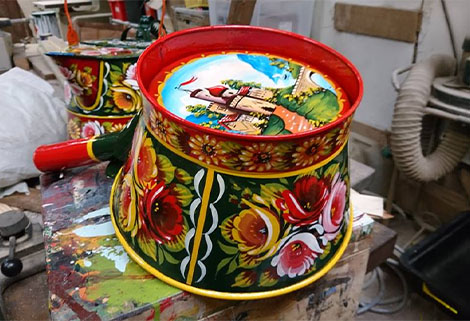
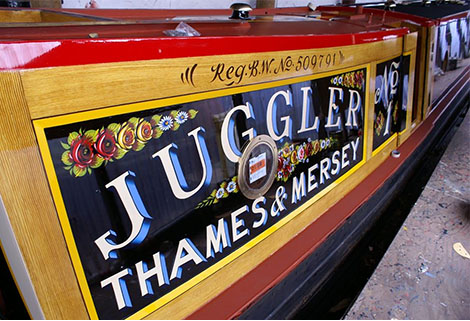
No1: Roses
- Around I.5 hours long.
- Filmed over the shoulder and with close ups of the various brushes as they work.
- All materials in use in any given process are listed on screen as well as described in the commentary along with verbal descriptions throughout.
- Two swags of roses painted. They are the same layout but the first is relatively basic and the second is much more developed.
No2: Castles
- Around I.5 hours long.
- Filmed over the shoulder and with close ups of the various brushes as they work.
- All materials in use in any given process are listed on screen as well as described in the commentary along with verbal descriptions throughout.
- One castle is painted.
.
No3: Signwriting
- Set of 5 DVDs, running time about 6.5 hours
- Starts with how to paint the simplest of block capital letters and goes through the alphabet as far as necessary
- It covers both sans-serif and serif letters
- Then how to lay out writing on a cabin side
- The whole finishing up on screen as a fully written panel with serif, sans and script lettering
 How to Paint Roses and How to Paint Castles are available for £13.50 each, or £25 for the two.
How to Paint Roses and How to Paint Castles are available for £13.50 each, or £25 for the two.
The 5 disc box set To the point - Signwriting is available for £25.
Email or ring Phil 07368 244866 for details and to order.
mna becomes volunteer ambassador for rnli
Merchant Navy Association (MNA) Boat Club become RNLI Ambassadors to promote the RNLI’s Respect the Water Campaign on the UK’s inland waterways. Their aim is to reduce the number of drownings around the coast and especially on our inland waterways.
Read More
MNA becomes volunteer ambassador for RNLI
MNA becomes volunteer ambassador for RNLI
Clive Edwards tells MNA members how they can become ambassadors for the RNLI
Merchant Navy Association (MNA) Boat Club become RNLI Ambassadors to promote the RNLI’s Respect the Water Campaign on the UK’s inland waterways
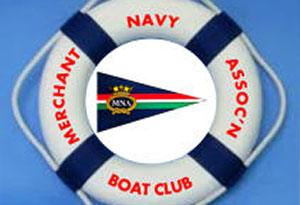 On behalf of the MNA Boat Club I’m delighted to announce the publication of the leaflet (transcribed below) outlining the partnership between the MNA Boat Club and the Royal National Lifeboat Institution (RNLI) to promote the RNLI’s “Respect the Water” campaign to reduce the number of drownings around the coast and especially on our inland waterways.
On behalf of the MNA Boat Club I’m delighted to announce the publication of the leaflet (transcribed below) outlining the partnership between the MNA Boat Club and the Royal National Lifeboat Institution (RNLI) to promote the RNLI’s “Respect the Water” campaign to reduce the number of drownings around the coast and especially on our inland waterways.
I am delighted that the hugely respected RNLI has recognised the experience, skill and knowledge of MNA members by choosing to work with the MNA Boat Club. The RNLI has now extended the opportunity to all members of the MNA with an invitation for them to play a part as “Ambassadors” in promoting the RNLI’s “Respect the Water” campaign aimed at significantly reducing the 150 plus fatalities each year as a result of drowning.
“I am delighted to be working alongside the MNA with this initiative. We have a variety of ways of promoting our safety messages, but nothing beats a face to face conversation with a knowledgeable person. MNA members acting as RNLI Volunteer Ambassadors will be able to pass on their experience and knowledge to others in order to save more lives around our coasts and waterways.” Steve Instance, RNLI Community Safety Partner.
This initiative has now been endorsed by Sir Robin Knox-Johnston who says “I am really pleased to see the Merchant Navy Association (MNA) Boat Club join forces with the RNLI to reach inland waterway users with safety messaging, helping to raise awareness of the Respect the Water campaign. MNA Boat Club members are former professional seafarers with a wealth of maritime experience and expertise so they are perfectly placed to support the RNLI’s prevention work in non-coastal waters. As a former Merchant Seaman and a Vice President of the RNLI, it’s great to see these two organisations working together to reduce accidental drowning in the UK.” Sir Robin Knox-Johnston CBE RD
For further information please contact:
Katie Beney, RNLI National Community Safety Partner, Email or Clive Edwards, MNA Boat Club Commodore Email
Why is the MNA supporting the RNLI?

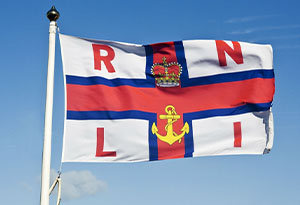
The RNLI’s mission is to reduce accidental drowning by 50% by 2024; around 150 lives are still lost at the coast every year. Through a combination of communication, products and face-to-face interaction, the RNLI’s Community Safety Team is driving behavioural change in and around the water. These interventions are delivered at a local level by some 500 Community Safety Volunteers across the UK and Ireland.
Most of these volunteers are based in coastal communities, close to RNLI lifeboat stations and lifeguarded beaches.
However, two in three accidental drowning fatalities take place at inland waterways.
The RNLI is collaborating with the MNA to reach these inland communities and coastal areas where they currently don’t have representation and/ or require additional support.
Working in conjunction with the MNA’s Boat Club members and SeaVue Surveillance Scheme will enable the RNLI to reach wider audiences with safety messaging and signpost water users to additional resources and support available. In doing so, the MNA will play a valuable role in helping the RNLI reduce accidental drownings by 2024.
“I am really pleased to see the Merchant Navy Association Boat Club join forces with the RNLI to reach inland waterway users with safety messaging, helping to raise awareness of the Respect the Water campaign. MNA Boat Club members are former professional seafarers with a wealth of maritime experience and expertise so they are perfectly placed to support the RNLI’s prevention work in non-coastal waters. As a former Merchant Seaman and a Vice President of the RNLI, it’s great to see these two organisations working together to reduce accidental drowning in the UK.” Sir Robin Knox-Johnston CBE RD #PreventingDrowningTogether
The role
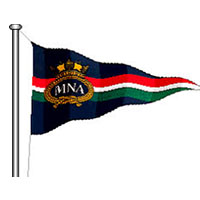
The RNLI is asking MNA Volunteer Ambassadors to promote safe practice on inland waterways and around the coast by communicating guidance to boat owners, watersports enthusiasts, marina operators, boat-hire companies, waterside pubs/restaurants and walkers. Using your maritime skills, knowledge and experience, you will be essential ambassadors for the RNLI’s safety messaging and Respect the Water campaign. This could be through passing conversation with fellow water users, discussing the latest means of calling for help and encouraging lifejacket use to distributing leaflets and posters to operators and venues.
Prior to getting out and about, the RNLI will discuss your locality with you to ensure there is no crossover with other volunteer networks.
Please note: there is no requirement to deliver safety presentations; should an individual/organisation require further advice, an RNLI Community Safety Volunteer will be available to deliver Advice Onboard sessions, Lifejacket Clinics etc.
Time commitment
As much or as little as you can offer
RNLI Respect the Water campaign
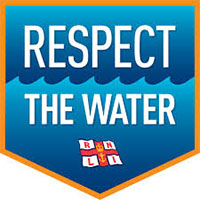
Respect the Water (RTW) is the RNLI’s national drowning prevention campaign. RTW is aimed at promoting safety advice to all who visit the coast and inland waterways, from walkers to commercial fishermen. RTW aims to show those most at risk the potential dangers of water, to encourage them to reconsider their actions, and adopt safer behaviour. Since 2017, it has focused on asking the public to fight their instincts and remember two memorable skills:
- floating which could save lives from drowning;
- and to call 999 or 112 and ask for the Coastguard.
The 2019 campaign launched on 30 May and ran through to the end of August with radio, cinema and print advertising and social media content.
Support and resources available
On agreeing to be an MNA Volunteer Ambassador you will receive a pack with further guidance, key safety messages and printed materials (leaflets and posters) to distribute in your agreed areas. You will also be sent a tally sheet to record conversations/ interventions to enable the RNLI to monitor reach and impact. Additional resources can be requested at any time.
The links below provide additional information and downloadable resources.
▪ www.respectthewater.com
public facing campaign website with practical advice on how to float with stories of survivors who have followed the advice
▪ www.rnli.org/rtwresources
here you will find all the resources you need to support the national RTW campaign and advice on key ‘at risk’ activities (angling, boating, walking, kayaking, scuba diving, commercial fishing and walking) plus ‘How To’ videos on fitting, checking and maintaining your life jacket.
▪ www.rnli.org/safety
essential safety advice so you can make the most of your time on the water
▪ www.rnli.org/safety/what-we-can-do-for-you
additional safety advice provided by RNLI Community Safety Volunteers
MNA contact
For further information on the MNA Boat Club and its collaboration with the RNLI, please contact Clive Edwards: Email
RNLI contact
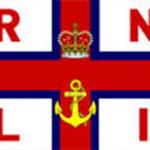
If you are interested in becoming an MNA Volunteer Ambassador, please contact Katie Beney in the first instance: Email
If you are based near a RNLI Lifeboat Station, Katie will put you in touch with the relevant contact at the station. If not, she will remain your point of contact and be able to provide assistance and resources to support your role.
Should you be interested in becoming a RNLI Community Safety Volunteer, working alongside your local RNLI Lifeboat Station, Katie will be able to make the relevant introductions.
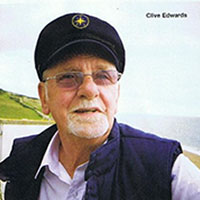 CLive Edwards, Commodore MNA Boat CLub: email
CLive Edwards, Commodore MNA Boat CLub: email
a fresh water warning
a fresh water warning
by Elliott Berry
 As some of you may know I contracted Leptospirosis in May 2014 and although I didn’t really want to write this article and elicit sympathy from anyone and have avoided writing it for a few years, I felt that now was the time especially with the increase in vessels being converted into houseboats.
As some of you may know I contracted Leptospirosis in May 2014 and although I didn’t really want to write this article and elicit sympathy from anyone and have avoided writing it for a few years, I felt that now was the time especially with the increase in vessels being converted into houseboats.
I was called to a vessel that was apparently sinking in the River Medway.
Upon arrival at the vessel it was clear that the vessel was in fact afloat still but had a large volume of water in the after cabins. My first response was to ascertain whether the water was indeed from an external source i.e river water or from an internal source i.e. a fresh water leak.
As I had done many times previously I conducted simple taste test and quickly ascertained that it was in fact “fresh” water. I then examined the vessel’s water system and found that all piping was still well installed and properly connected and that the water tank was in good order with no sign of leaks, a mystery indeed.
I advised the owner to pump out the water and to keep the area under observation and to call me if any further water were to appear. After six or seven days I had heard nothing.
During the next couple of days, I had been doing some work in the garden at home and started to feel unwell but initially I put that down to having overdone it. Over the next few hours I started to feel weak and developed a serious headache, at this point I rang the doctor and made an appointment. Initially the doctor intimated that it may be meningitis but that as I had no rash or sensitivity to light was quickly dismissed. The advice was to go home, drink lots of water and take paracetamol and to return in a few days if the symptom persisted.
Unusually for me I followed the doctor’s orders but the weakness and headache became progressively worse and I developed uncontrollable shivering and so a visit to the Accident and Emergency department ensued upon which it was decided that I had contracted hepatitis A and should go home, drink lots of water and take paracetamol.
That night my wife became increasingly concerned as I had developed a fever so a further visit to hospital was undertaken. Upon arrival, it was clear to the doctors that something was seriously wrong and I was admitted immediately and placed on a saline drip.
The next few hours are a bit of a blur but a huge number of blood tests, CT scans and ultrasounds were carried out and initially nothing was diagnosed although the blood tests showed that my liver had extremely elevated readings.
I was given numerous antibiotics and liquid paracetamol over a 24 hour period but the 41 degree fever would not subside, to the point that it was clear that my life was at risk.
A series of different medications were administered to me and, after eight days in hospital, I had recovered sufficiently to return home although at that point nothing had been officially diagnosed and the only possible suggestion to fit the symptoms was leptospirosis despite not showing up in blood tests.
After a further three weeks convalescing, I was able to return to work and some investigation into what may have caused the illness was undertaken.
As it turned out, the vessel in question had been converted to a houseboat some twenty years previously and the bilges were cleaned out but, instead of disposing of the contents properly, the liquid and debris were placed into one of her ballast tanks. The tank had subsequently corroded from the inside and had deposited its contents into the aft cabin ready for an unsuspecting surveyor to taste it. Obviously, the true contents of the water are unknown but I can assure you that I no longer undertake taste tests on water and advise that no one else does the same.
In order to prevent anyone suffering the same as I did, I thought it prudent to highlight the dangers faced when working in or around water.
Introduction to Leptospirosis
Leptospirosis is a bacterial infection caused by certain members of the genus leptospira.
 Most people who develop a leptospirosis infection only get mild symptoms but a bit more serious influenza- like symptoms are also quite common. In a minority of infected persons, leptospirosis develops into the dreaded Weill’s disease. Weill’s disease is a serious condition that can involve liver failure, kidney failure, meningitis and sepsis. Weill’s disease can be fatal.
Most people who develop a leptospirosis infection only get mild symptoms but a bit more serious influenza- like symptoms are also quite common. In a minority of infected persons, leptospirosis develops into the dreaded Weill’s disease. Weill’s disease is a serious condition that can involve liver failure, kidney failure, meningitis and sepsis. Weill’s disease can be fatal.
Weill’s disease is caused by leptospira interrogans belonging to the serogroup Icterohaemorrhagiae or Pomona. A person who develops Weill’s disease will usually have gone through influenza like symptoms of leptospirosis for a week or so and seemingly be well on their way to recovery. After a short period of no symptoms or only mild symptoms, the person gets very ill with symptoms of poor liver function, poor kidney functions, meningitis and/or sepsis. The lethality for Weill’s disease is 5% – 10%.
Transmission
Urine and blood from a leptospirosis infected person or animal can contain a sufficient amount of bacteria to spread the disease. A common transmission route for humans is getting urine or blood from an infected animal on damaged skin. Even a tiny skin abrasion can be enough for the bacteria to get into the body. Leptospira bacteria can also enter the body through mucous membranes, e.g. those found in the eyes, nose, mouth and genitals.
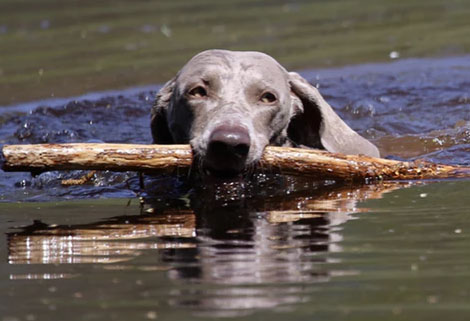 When infected blood or urine gets into water or soil, the bacteria can survive there for several months.
When infected blood or urine gets into water or soil, the bacteria can survive there for several months.
Many different animals can carry and transmit leptospirosis, including dogs, rodents, cattle, horses and pigs. An infected animal is often symptom free and can continue to excrete bacteria into the environment year after year.
The incubation time for leptospirosis in humans is usually one to two weeks but anywhere from 48 hours to more than a month has been reported.
Symptoms
Examples of symptoms from the eyes
- Eye inflammation can occur, with reddening of the eyes and increased sensitivity to light.
- If leptospirosis bacteria causes liver inflammation with poor liver function as a result, one noticeable symptom can be the yellowing of the sclera. The sclera is the white part of the eye; the part that surrounds the iris. When the liver isn’t working properly, the sclera becomes yellow due to increased levels of bilirubin in the body. In some cases, the sclera can even look greenish. Always check your eyes before you put in your contact lenses if you wear colored lenses. If you do not you risk not seeing the symptoms of leptospirosis, liver damage and a long row of different diseases.
Examples of symptoms from the skin
- Skin rash
- If leptospirosis bacteria causes liver inflammation with poor liver function as a result, symptoms can include the yellowing of the skin due to increased levels of bilirubin. In such situations, itchy skin is also common. In severe cases, the skin can look greenish rather than yellowish.
Examples of symptoms from the digestive system
- Stomach ache
- Diarrhea
- Vomiting
- If leptospirosis bacteria causes liver inflammation with poor liver function as a result, symptoms can include pale faeces and dark urine.
Examples of symptoms from the respiratory system
- Coughing up blood (caused by lung bleeding)
Examples of other symptoms
- High fever
- Chills
- Headache
- Muscle ache
Edema Treatment
Leptospira bacteria are sensitive to several different antibiotics, including well-known ones such as Penicillin and Doxycycline.
If the infection is diagnosed early and symptoms are mild, oral antibiotics are often sufficient. In more severe cases, intravenous treatment with antibiotics may be necessary. Each individual symptom can also require specific treatment. If kidney function is impaired, dialysis can be carried out.
When an MD has good reason to suspect leptospirosis in a patient, antibiotic treatment is typically started right away, without waiting for test results.
How quickly can an illness develop?
Human leptospirosis takes a while to incubate, and the normal range between exposure and illness is 3 to 14 days, although it can take up to 21 days. It’s considered extremely unlikely that the illness would show earlier than 24 hours after exposure, even if the patient was otherwise unwell. In rare cases the incubation time can be very long (several weeks) but we normally assume that if there is no illness after 30 days then infection is either not present, or was subclinical.
Illness that develops within 12 hours of the exposure event would not be leptospiral in origin. Often infections that involve contaminated water can show illness very rapidly, caused by the effects of other unrelated bacteria and viruses in the water (such as E.coli or cryptosporidium) or from some chemicals, and while these would not in themselves normally be life-threatening, they can mask the later symptoms of leptospirosis.
The incubation time depends on the strain of bacteria involved, as some strains reproduce faster in human blood than others, but the main factor is the size of the ‘inoculum’ – the dose of bacteria that entered the patient during their exposure. Although it’s perfectly possible to be infected from a single bacterium, in reality the illness develops because the rate that the bacteria are reproducing is faster than the patient’s immune system can control. Bacteria grow by splitting in half, so one becomes two, two become four, and so on. If the patient received a large number of bacteria from the initial contact then the numbers in their bloodstream will be larger, and increase faster – hence the illness develops sooner.
It’s very difficult to predict the incubation time in a patient, but in very general terms the concentration of bacteria in the inoculum will be important (water from a large clean river will have many times less bacteria per litre than urine direct from a rat) and the volume that enters the body (infection via small cuts to the skin usually involve very small volumes of liquid, but swallowing water after a fall into a lake will of course involve far more. The balance of course is that the situations where patients suffer a high-volume intake are usually those where the liquid has a low concentration (you are unlikely to fall into a tank of rat urine).
Precautions against infection
To minimise the chances of infection, the only truly effective way is to avoid contact with contaminated water and animals, thus avoiding exposure to the bacterium. If you are in a high risk area, you should always attempt to minimise contact, as there are many hundreds of other organisms that can lurk in the water apart from Leptospira. Unless you are required to enter the water, you should stay away from it. Animals themselves present a risk while infected, as their body fluids can contain the bacteria.
Water
The vast majority of human cases are from contaminated water, and of those the majority are occupational cases from areas of the world where agriculture and rodents mix – rice-farming, cane-growing and so forth. Recreational exposure is next, with cases amongst swimmers being the obvious top grouping. Lowest of the risk groups is occupational exposure in the developed world – water and sewer engineers, construction, pest control and so on.
Clearly there are problems in preventing exposure in the highest risk activities (rice-farming and such) and in those areas the only option is to be aware of symptoms and seek early treatment. At this time there is no universally-agreed human vaccine, and the preventative use of antibiotics can only be considered for short periods.
Swimming is the greatest risk, and several cases are reported each year from swimming in contaminated water (both in the developed world and in activities such as adventure racing). There is no practical way to prevent exposure as some water will always enter the mouth. For one-off activities such as expeditions there is an argument for using a preventative antibiotic (doxycycline) which can offer increased resistance to illness for a few weeks. It should never be used long-term.
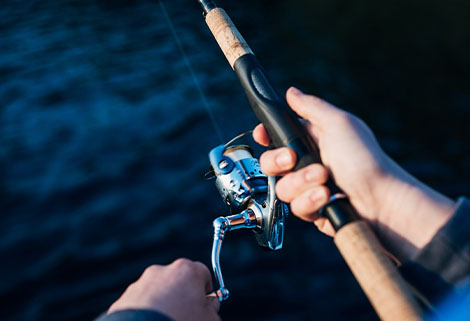 Anglers and bankside/sewer workers should wear splashproof clothing and expecially gloves. Anglers are at higher risk as it is reasonably common to cause minor cuts with hooks, knives and the like, and this greatly increases the ease by which the bacteria can enter the body. Fish caught from suspect areas should of course never be eaten. Whilst cooking does in theory kill any bacteria within a fish, very often the level of cooking is insufficient to guarantee safety.
Anglers and bankside/sewer workers should wear splashproof clothing and expecially gloves. Anglers are at higher risk as it is reasonably common to cause minor cuts with hooks, knives and the like, and this greatly increases the ease by which the bacteria can enter the body. Fish caught from suspect areas should of course never be eaten. Whilst cooking does in theory kill any bacteria within a fish, very often the level of cooking is insufficient to guarantee safety.
Recreational exposure (swimming, skiing, sailing, caving, etc) is clearly done at the person’s own risk and they must weigh up their own balance of risk vs. desire. The same preventative measures apply – minimise the risk of water entering the body by any and all means, consider antibiotics if the risks are very high, and be aware of the symptoms and seek treatment immediately. There are no ‘quick fixes’ to prevent infection. Some swimmers wash their mouths with antibacterial rinse, though this has not been proved to offer any significant benefit other than keeping their teeth clean.
Scuba divers, who are particularly at risk, should opt for drysuits and try as much as possible to avoid swallowing any water when purging or changing regs. Commercial divers are required by their employment regulations and insurance to comply with strict rules when working in contaminated water, these include the use of hard-hat systems, wash-down stations and regular medical testing.
Remember that this advice applies to FRESH water – the risks in saltwater are virtually zero.
 Elliott Berry is the owner of Marsurv, Independent Marine Surveyors and Consultants, and is himself an independent Marine Surveyor/Naval Architect & Consultant.
Elliott Berry is the owner of Marsurv, Independent Marine Surveyors and Consultants, and is himself an independent Marine Surveyor/Naval Architect & Consultant.
This article was first produced for and published by The Report in June 2017
Call: 0844 567 7709 / 07500 881731; Visit website or write
